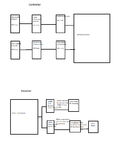obrien136
Junior Member level 2
Hello,
I was working on a 27KHz RC controller using tone generators in the transmitter and tone decoders in the receiver. It's kind of a PWM CW signal modulating a 27MHz carrier. The problem is I couldn't get the LM567 tone decoders to work. Attached is a block diagram of it. Does anybody else want to take a try at it?

I was working on a 27KHz RC controller using tone generators in the transmitter and tone decoders in the receiver. It's kind of a PWM CW signal modulating a 27MHz carrier. The problem is I couldn't get the LM567 tone decoders to work. Attached is a block diagram of it. Does anybody else want to take a try at it?

Last edited: